Project Financing and Development Bank Analysis
VerifiedAdded on 2021/04/16
|22
|4039
|54
AI Summary
The assignment details the financial assistance provided by the Asian Development Bank to companies, including direct funding through equity investment and loans. It also explains how the bank helps protect companies from political risks and organizes additional debt resources for financing projects.
Contribute Materials
Your contribution can guide someone’s learning journey. Share your
documents today.
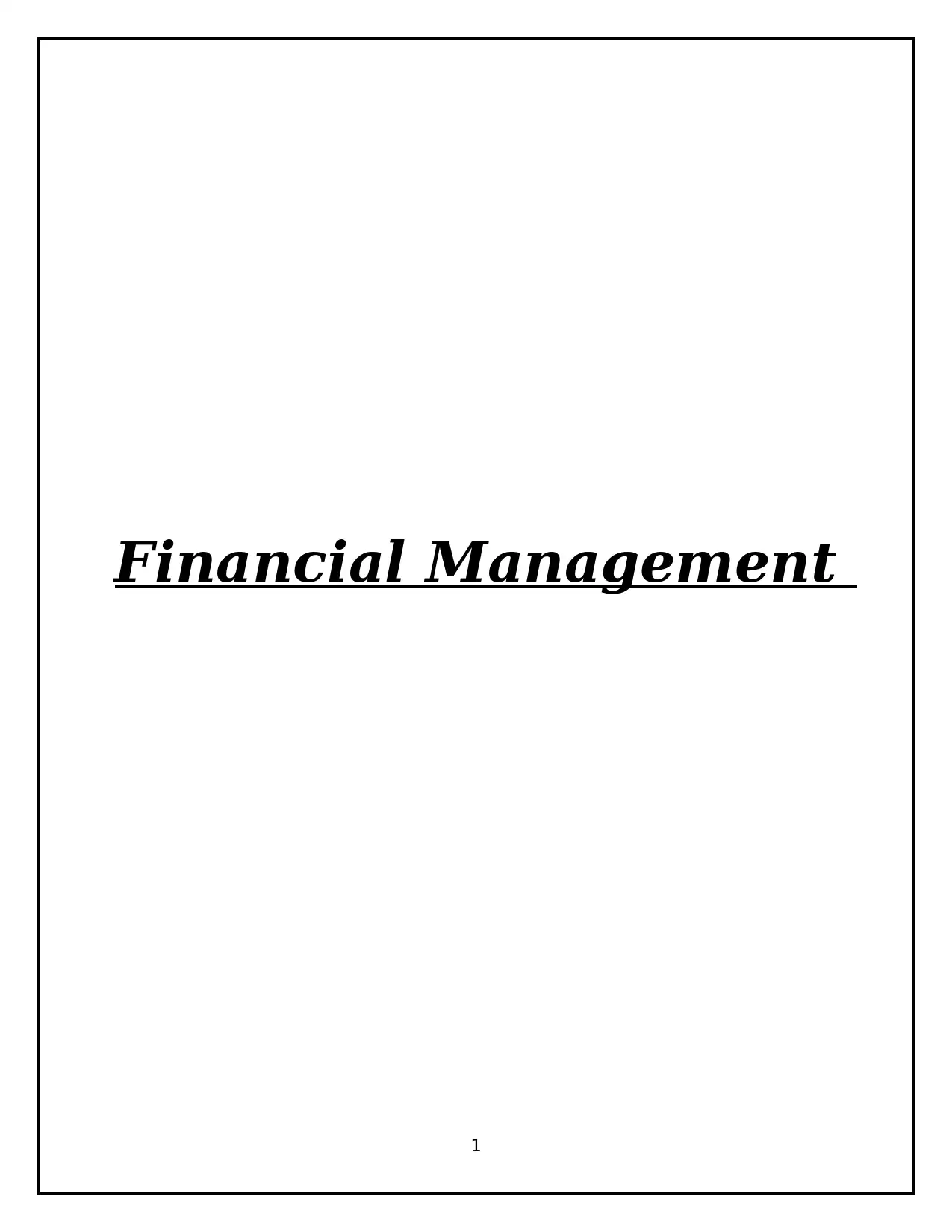
Financial Management
1
1
Secure Best Marks with AI Grader
Need help grading? Try our AI Grader for instant feedback on your assignments.
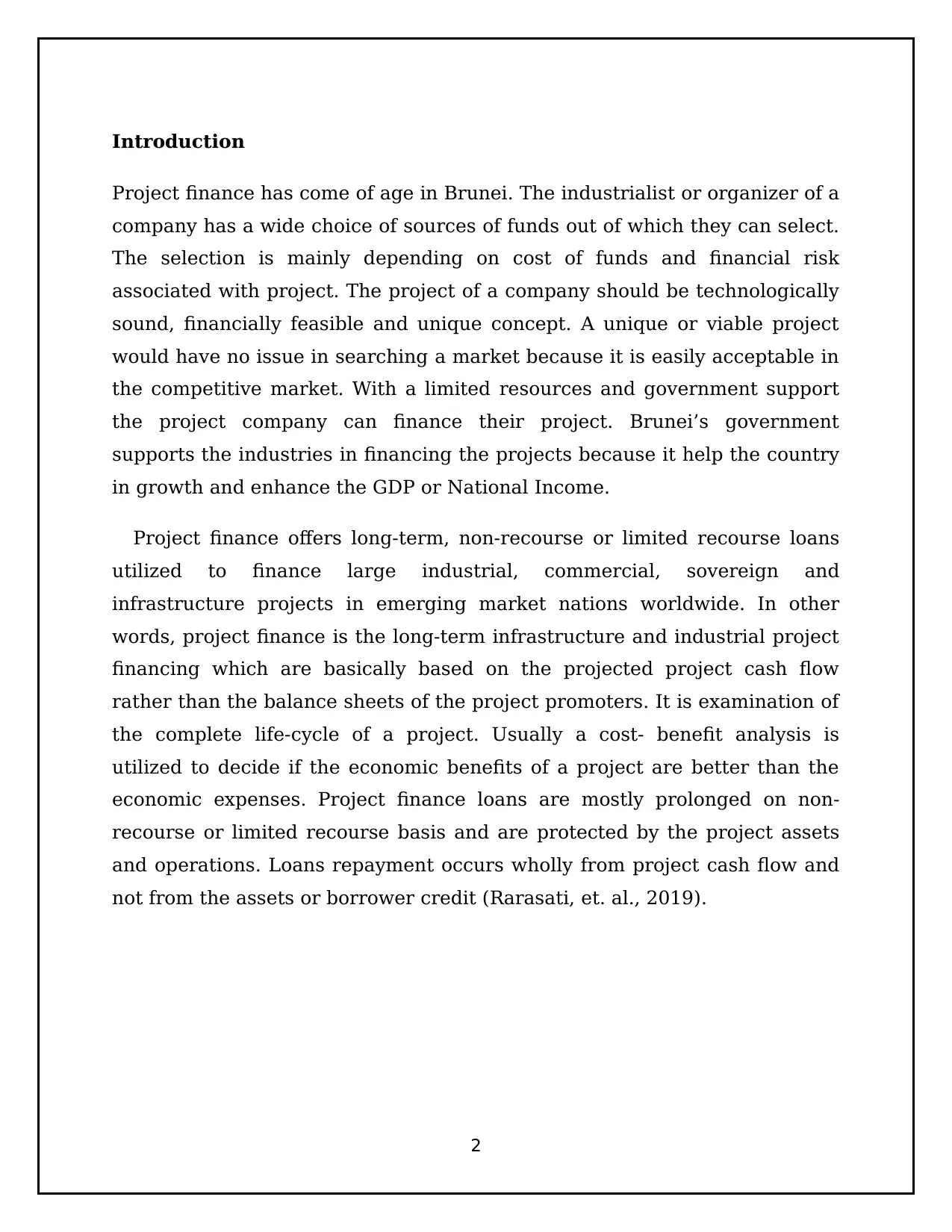
Introduction
Project finance has come of age in Brunei. The industrialist or organizer of a
company has a wide choice of sources of funds out of which they can select.
The selection is mainly depending on cost of funds and financial risk
associated with project. The project of a company should be technologically
sound, financially feasible and unique concept. A unique or viable project
would have no issue in searching a market because it is easily acceptable in
the competitive market. With a limited resources and government support
the project company can finance their project. Brunei’s government
supports the industries in financing the projects because it help the country
in growth and enhance the GDP or National Income.
Project finance offers long-term, non-recourse or limited recourse loans
utilized to finance large industrial, commercial, sovereign and
infrastructure projects in emerging market nations worldwide. In other
words, project finance is the long-term infrastructure and industrial project
financing which are basically based on the projected project cash flow
rather than the balance sheets of the project promoters. It is examination of
the complete life-cycle of a project. Usually a cost- benefit analysis is
utilized to decide if the economic benefits of a project are better than the
economic expenses. Project finance loans are mostly prolonged on non-
recourse or limited recourse basis and are protected by the project assets
and operations. Loans repayment occurs wholly from project cash flow and
not from the assets or borrower credit (Rarasati, et. al., 2019).
2
Project finance has come of age in Brunei. The industrialist or organizer of a
company has a wide choice of sources of funds out of which they can select.
The selection is mainly depending on cost of funds and financial risk
associated with project. The project of a company should be technologically
sound, financially feasible and unique concept. A unique or viable project
would have no issue in searching a market because it is easily acceptable in
the competitive market. With a limited resources and government support
the project company can finance their project. Brunei’s government
supports the industries in financing the projects because it help the country
in growth and enhance the GDP or National Income.
Project finance offers long-term, non-recourse or limited recourse loans
utilized to finance large industrial, commercial, sovereign and
infrastructure projects in emerging market nations worldwide. In other
words, project finance is the long-term infrastructure and industrial project
financing which are basically based on the projected project cash flow
rather than the balance sheets of the project promoters. It is examination of
the complete life-cycle of a project. Usually a cost- benefit analysis is
utilized to decide if the economic benefits of a project are better than the
economic expenses. Project finance loans are mostly prolonged on non-
recourse or limited recourse basis and are protected by the project assets
and operations. Loans repayment occurs wholly from project cash flow and
not from the assets or borrower credit (Rarasati, et. al., 2019).
2
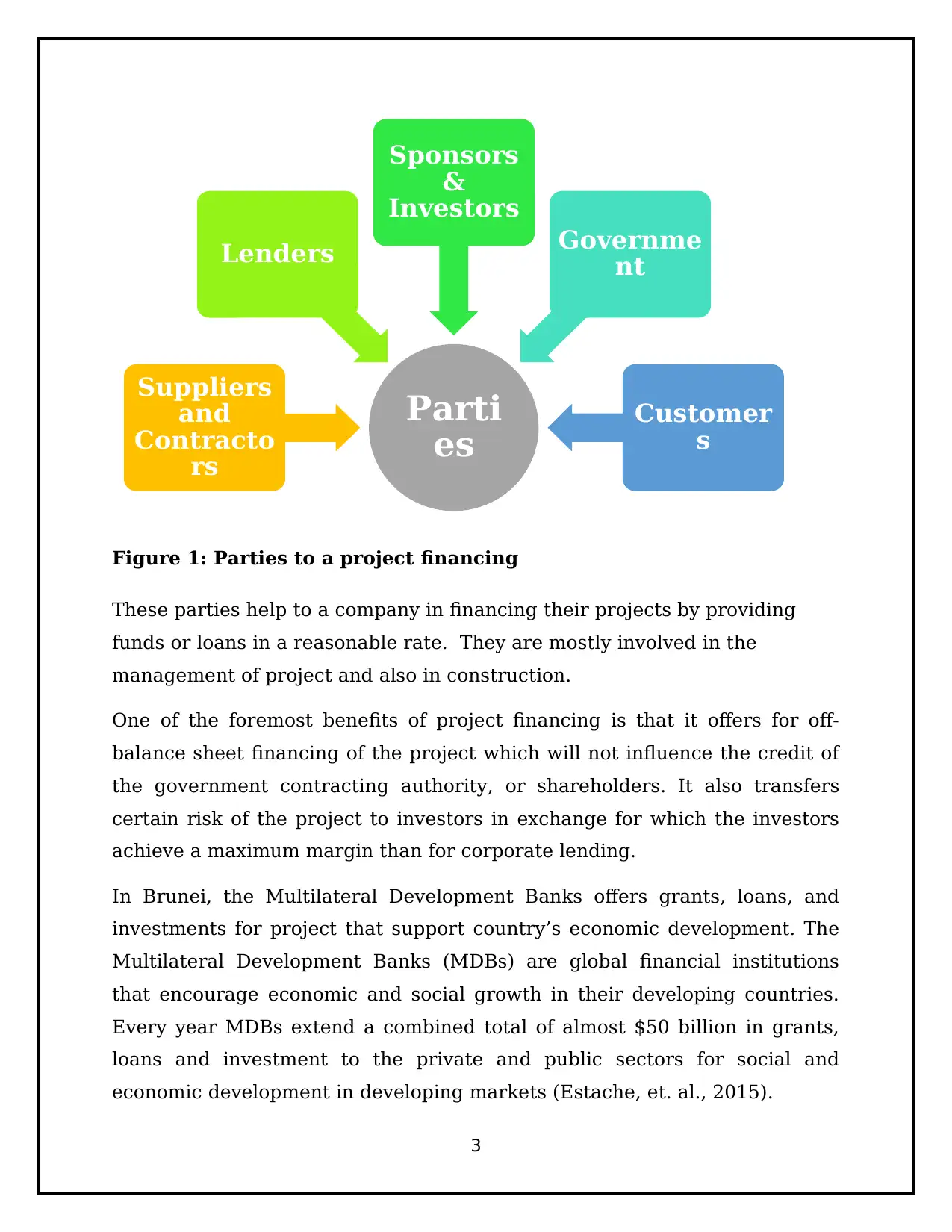
Figure 1: Parties to a project financing
These parties help to a company in financing their projects by providing
funds or loans in a reasonable rate. They are mostly involved in the
management of project and also in construction.
One of the foremost benefits of project financing is that it offers for off-
balance sheet financing of the project which will not influence the credit of
the government contracting authority, or shareholders. It also transfers
certain risk of the project to investors in exchange for which the investors
achieve a maximum margin than for corporate lending.
In Brunei, the Multilateral Development Banks offers grants, loans, and
investments for project that support country’s economic development. The
Multilateral Development Banks (MDBs) are global financial institutions
that encourage economic and social growth in their developing countries.
Every year MDBs extend a combined total of almost $50 billion in grants,
loans and investment to the private and public sectors for social and
economic development in developing markets (Estache, et. al., 2015).
3
Parti
es
Suppliers
and
Contracto
rs
Lenders
Sponsors
&
Investors
Governme
nt
Customer
s
These parties help to a company in financing their projects by providing
funds or loans in a reasonable rate. They are mostly involved in the
management of project and also in construction.
One of the foremost benefits of project financing is that it offers for off-
balance sheet financing of the project which will not influence the credit of
the government contracting authority, or shareholders. It also transfers
certain risk of the project to investors in exchange for which the investors
achieve a maximum margin than for corporate lending.
In Brunei, the Multilateral Development Banks offers grants, loans, and
investments for project that support country’s economic development. The
Multilateral Development Banks (MDBs) are global financial institutions
that encourage economic and social growth in their developing countries.
Every year MDBs extend a combined total of almost $50 billion in grants,
loans and investment to the private and public sectors for social and
economic development in developing markets (Estache, et. al., 2015).
3
Parti
es
Suppliers
and
Contracto
rs
Lenders
Sponsors
&
Investors
Governme
nt
Customer
s
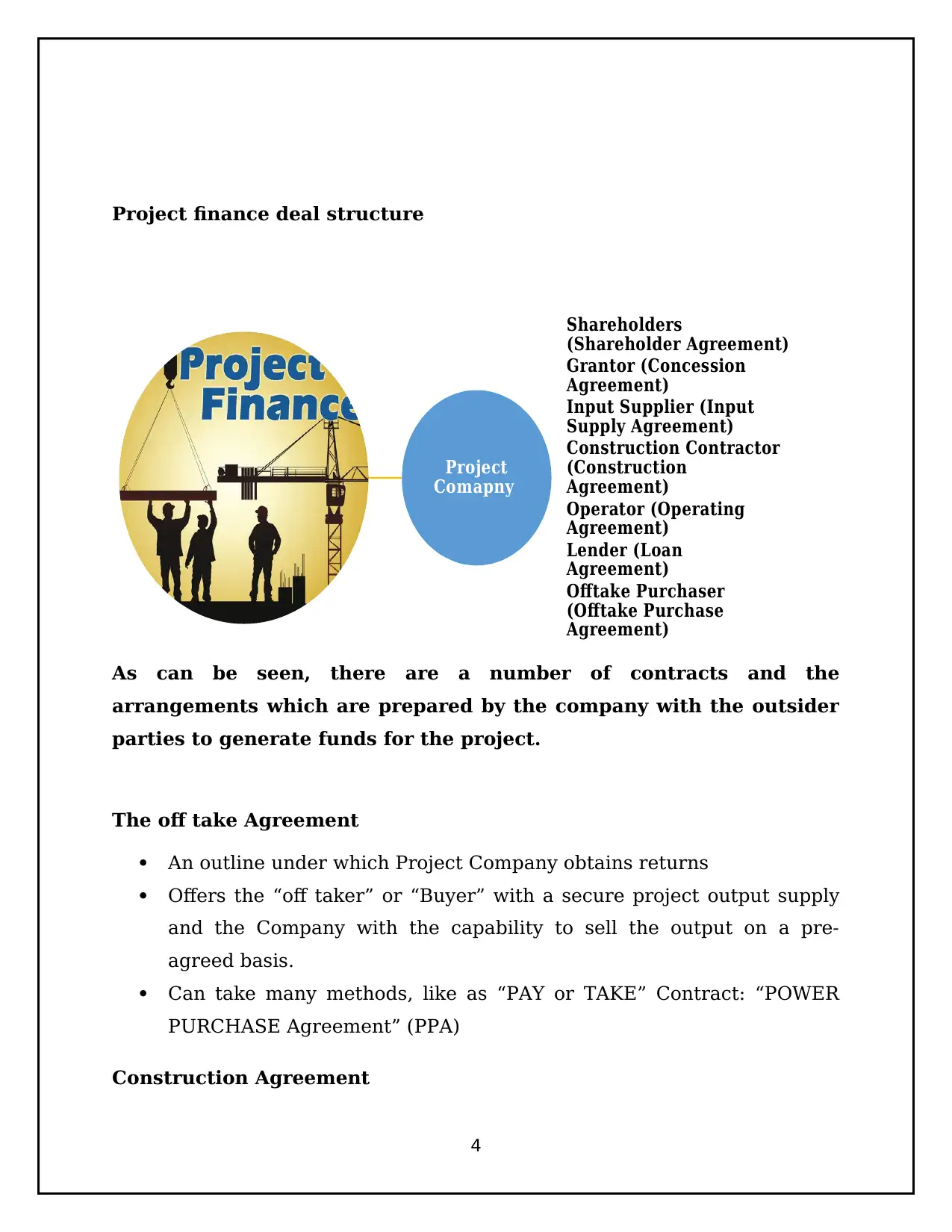
Project finance deal structure
As can be seen, there are a number of contracts and the
arrangements which are prepared by the company with the outsider
parties to generate funds for the project.
The off take Agreement
An outline under which Project Company obtains returns
Offers the “off taker” or “Buyer” with a secure project output supply
and the Company with the capability to sell the output on a pre-
agreed basis.
Can take many methods, like as “PAY or TAKE” Contract: “POWER
PURCHASE Agreement” (PPA)
Construction Agreement
4
Project
Comapny
Shareholders
(Shareholder Agreement)
Grantor (Concession
Agreement)
Input Supplier (Input
Supply Agreement)
Construction Contractor
(Construction
Agreement)
Operator (Operating
Agreement)
Lender (Loan
Agreement)
Offtake Purchaser
(Offtake Purchase
Agreement)
As can be seen, there are a number of contracts and the
arrangements which are prepared by the company with the outsider
parties to generate funds for the project.
The off take Agreement
An outline under which Project Company obtains returns
Offers the “off taker” or “Buyer” with a secure project output supply
and the Company with the capability to sell the output on a pre-
agreed basis.
Can take many methods, like as “PAY or TAKE” Contract: “POWER
PURCHASE Agreement” (PPA)
Construction Agreement
4
Project
Comapny
Shareholders
(Shareholder Agreement)
Grantor (Concession
Agreement)
Input Supplier (Input
Supply Agreement)
Construction Contractor
(Construction
Agreement)
Operator (Operating
Agreement)
Lender (Loan
Agreement)
Offtake Purchaser
(Offtake Purchase
Agreement)
Secure Best Marks with AI Grader
Need help grading? Try our AI Grader for instant feedback on your assignments.
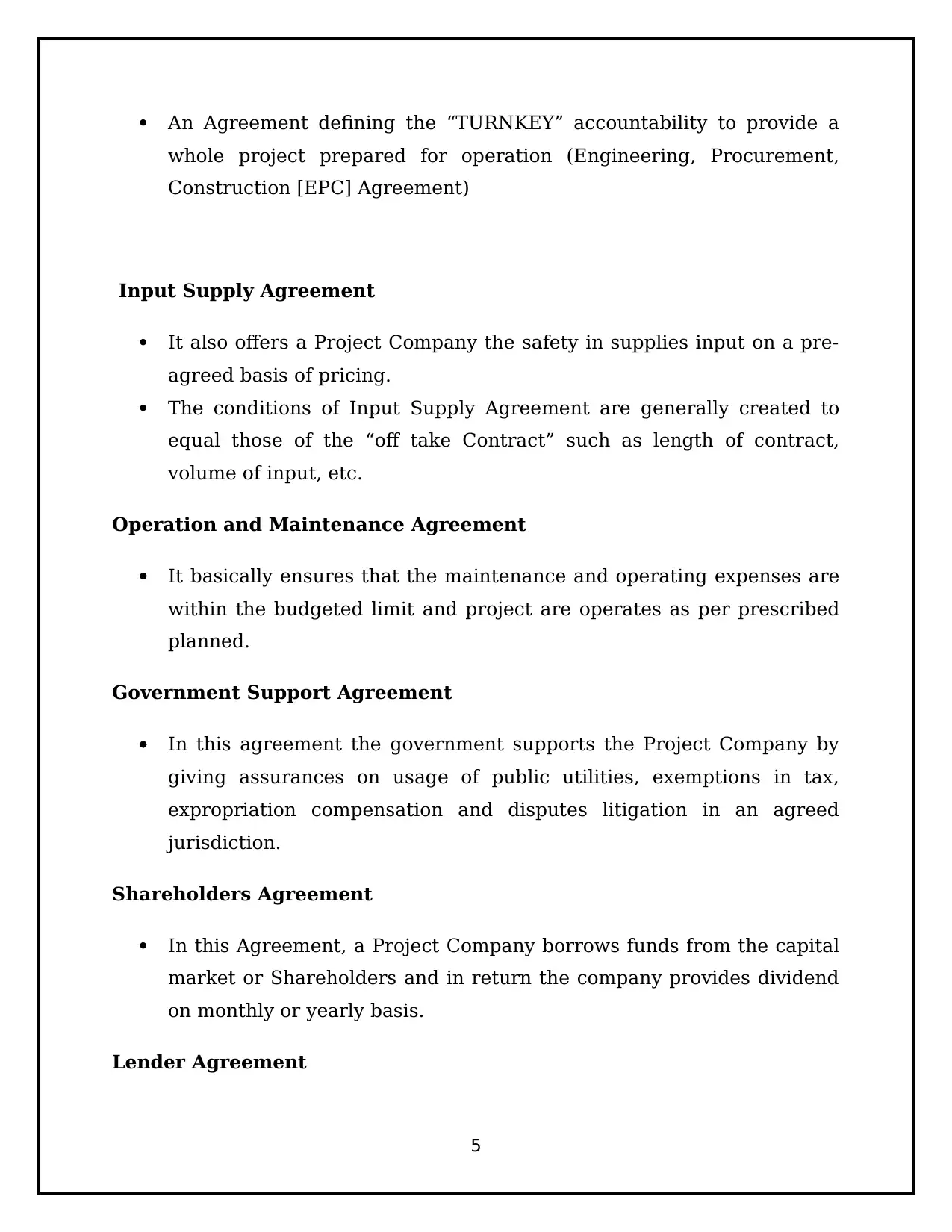
An Agreement defining the “TURNKEY” accountability to provide a
whole project prepared for operation (Engineering, Procurement,
Construction [EPC] Agreement)
Input Supply Agreement
It also offers a Project Company the safety in supplies input on a pre-
agreed basis of pricing.
The conditions of Input Supply Agreement are generally created to
equal those of the “off take Contract” such as length of contract,
volume of input, etc.
Operation and Maintenance Agreement
It basically ensures that the maintenance and operating expenses are
within the budgeted limit and project are operates as per prescribed
planned.
Government Support Agreement
In this agreement the government supports the Project Company by
giving assurances on usage of public utilities, exemptions in tax,
expropriation compensation and disputes litigation in an agreed
jurisdiction.
Shareholders Agreement
In this Agreement, a Project Company borrows funds from the capital
market or Shareholders and in return the company provides dividend
on monthly or yearly basis.
Lender Agreement
5
whole project prepared for operation (Engineering, Procurement,
Construction [EPC] Agreement)
Input Supply Agreement
It also offers a Project Company the safety in supplies input on a pre-
agreed basis of pricing.
The conditions of Input Supply Agreement are generally created to
equal those of the “off take Contract” such as length of contract,
volume of input, etc.
Operation and Maintenance Agreement
It basically ensures that the maintenance and operating expenses are
within the budgeted limit and project are operates as per prescribed
planned.
Government Support Agreement
In this agreement the government supports the Project Company by
giving assurances on usage of public utilities, exemptions in tax,
expropriation compensation and disputes litigation in an agreed
jurisdiction.
Shareholders Agreement
In this Agreement, a Project Company borrows funds from the capital
market or Shareholders and in return the company provides dividend
on monthly or yearly basis.
Lender Agreement
5
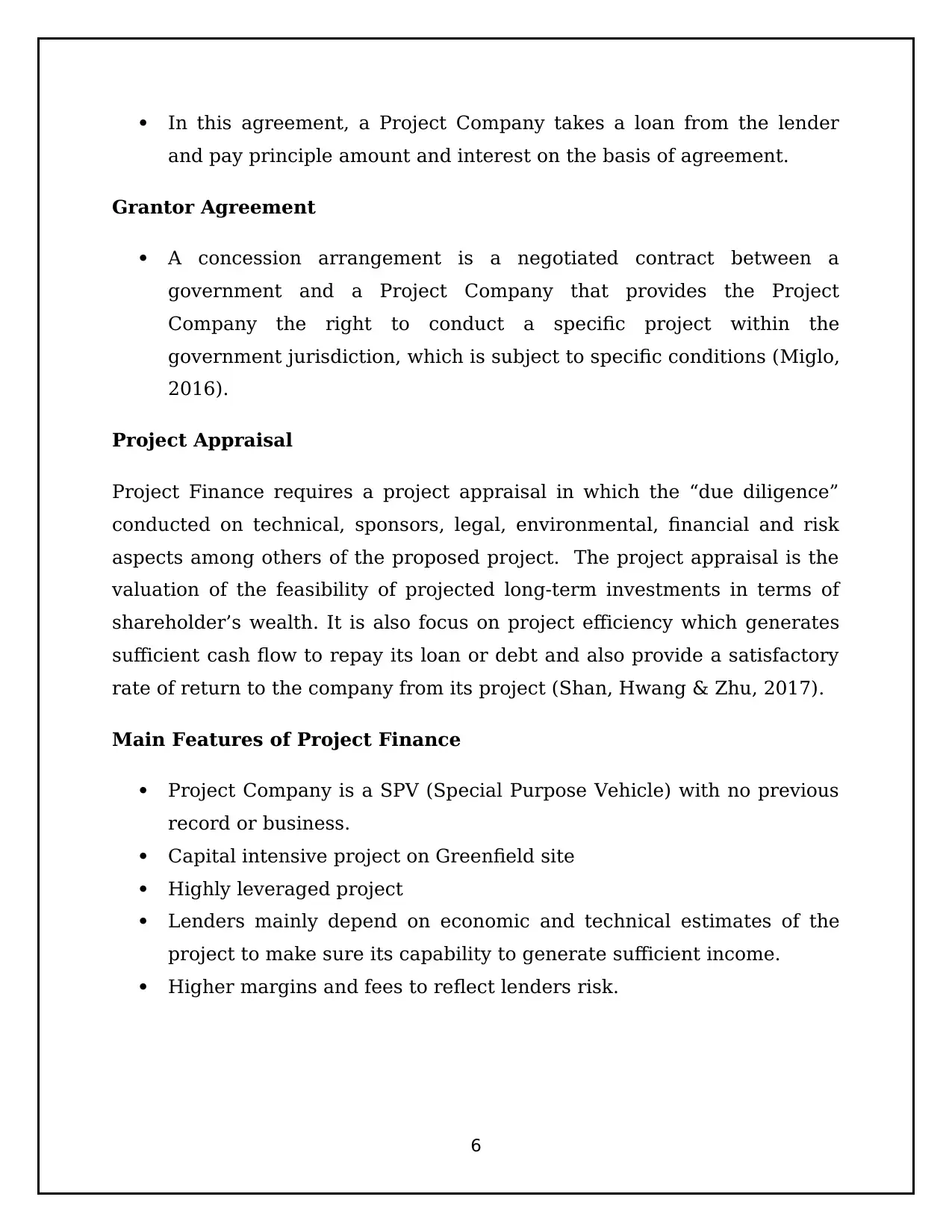
In this agreement, a Project Company takes a loan from the lender
and pay principle amount and interest on the basis of agreement.
Grantor Agreement
A concession arrangement is a negotiated contract between a
government and a Project Company that provides the Project
Company the right to conduct a specific project within the
government jurisdiction, which is subject to specific conditions (Miglo,
2016).
Project Appraisal
Project Finance requires a project appraisal in which the “due diligence”
conducted on technical, sponsors, legal, environmental, financial and risk
aspects among others of the proposed project. The project appraisal is the
valuation of the feasibility of projected long-term investments in terms of
shareholder’s wealth. It is also focus on project efficiency which generates
sufficient cash flow to repay its loan or debt and also provide a satisfactory
rate of return to the company from its project (Shan, Hwang & Zhu, 2017).
Main Features of Project Finance
Project Company is a SPV (Special Purpose Vehicle) with no previous
record or business.
Capital intensive project on Greenfield site
Highly leveraged project
Lenders mainly depend on economic and technical estimates of the
project to make sure its capability to generate sufficient income.
Higher margins and fees to reflect lenders risk.
6
and pay principle amount and interest on the basis of agreement.
Grantor Agreement
A concession arrangement is a negotiated contract between a
government and a Project Company that provides the Project
Company the right to conduct a specific project within the
government jurisdiction, which is subject to specific conditions (Miglo,
2016).
Project Appraisal
Project Finance requires a project appraisal in which the “due diligence”
conducted on technical, sponsors, legal, environmental, financial and risk
aspects among others of the proposed project. The project appraisal is the
valuation of the feasibility of projected long-term investments in terms of
shareholder’s wealth. It is also focus on project efficiency which generates
sufficient cash flow to repay its loan or debt and also provide a satisfactory
rate of return to the company from its project (Shan, Hwang & Zhu, 2017).
Main Features of Project Finance
Project Company is a SPV (Special Purpose Vehicle) with no previous
record or business.
Capital intensive project on Greenfield site
Highly leveraged project
Lenders mainly depend on economic and technical estimates of the
project to make sure its capability to generate sufficient income.
Higher margins and fees to reflect lenders risk.
6
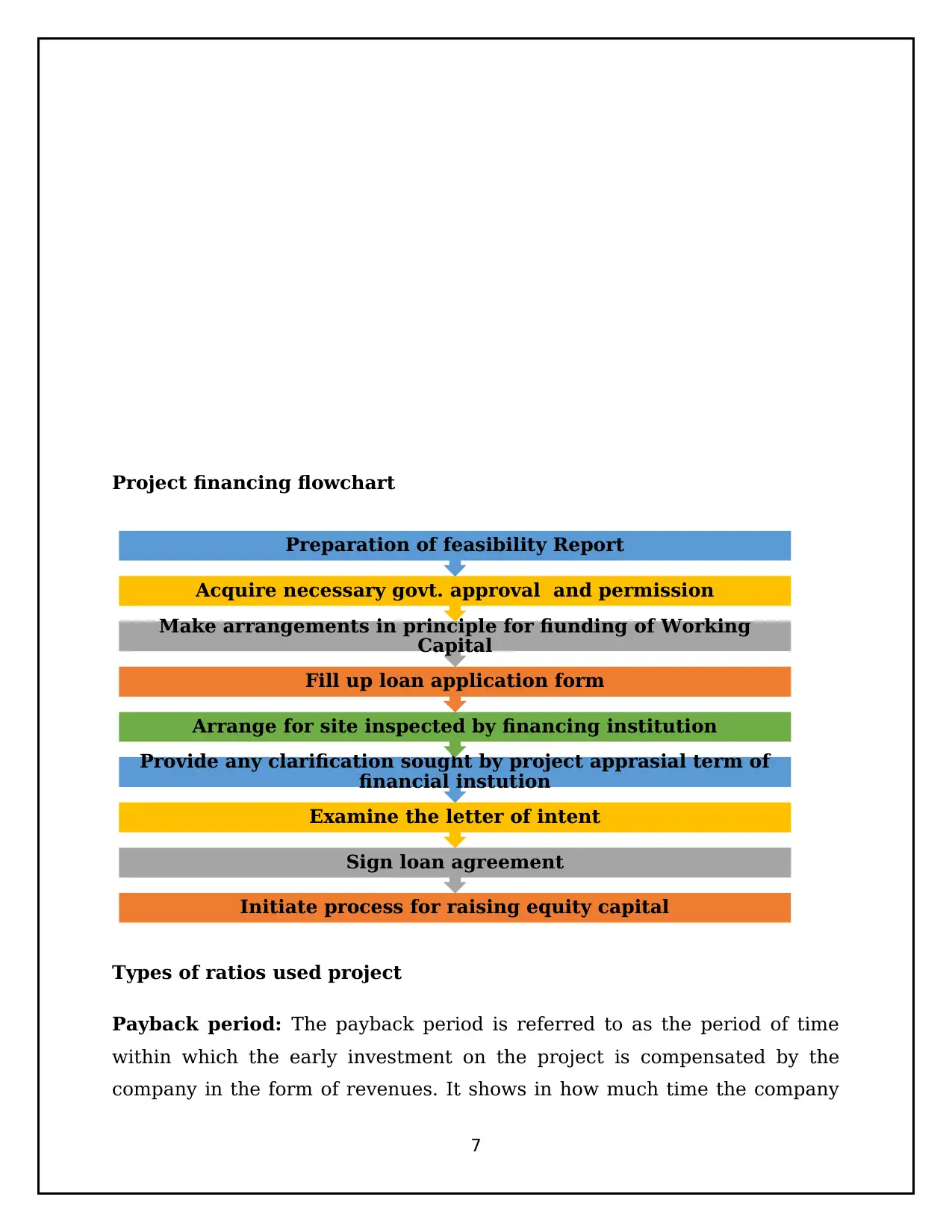
Project financing flowchart
Types of ratios used project
Payback period: The payback period is referred to as the period of time
within which the early investment on the project is compensated by the
company in the form of revenues. It shows in how much time the company
7
Initiate process for raising equity capital
Sign loan agreement
Examine the letter of intent
Provide any clarification sought by project apprasial term of
financial instution
Arrange for site inspected by financing institution
Fill up loan application form
Make arrangements in principle for fiunding of Working
Capital
Acquire necessary govt. approval and permission
Preparation of feasibility Report
Types of ratios used project
Payback period: The payback period is referred to as the period of time
within which the early investment on the project is compensated by the
company in the form of revenues. It shows in how much time the company
7
Initiate process for raising equity capital
Sign loan agreement
Examine the letter of intent
Provide any clarification sought by project apprasial term of
financial instution
Arrange for site inspected by financing institution
Fill up loan application form
Make arrangements in principle for fiunding of Working
Capital
Acquire necessary govt. approval and permission
Preparation of feasibility Report
Paraphrase This Document
Need a fresh take? Get an instant paraphrase of this document with our AI Paraphraser
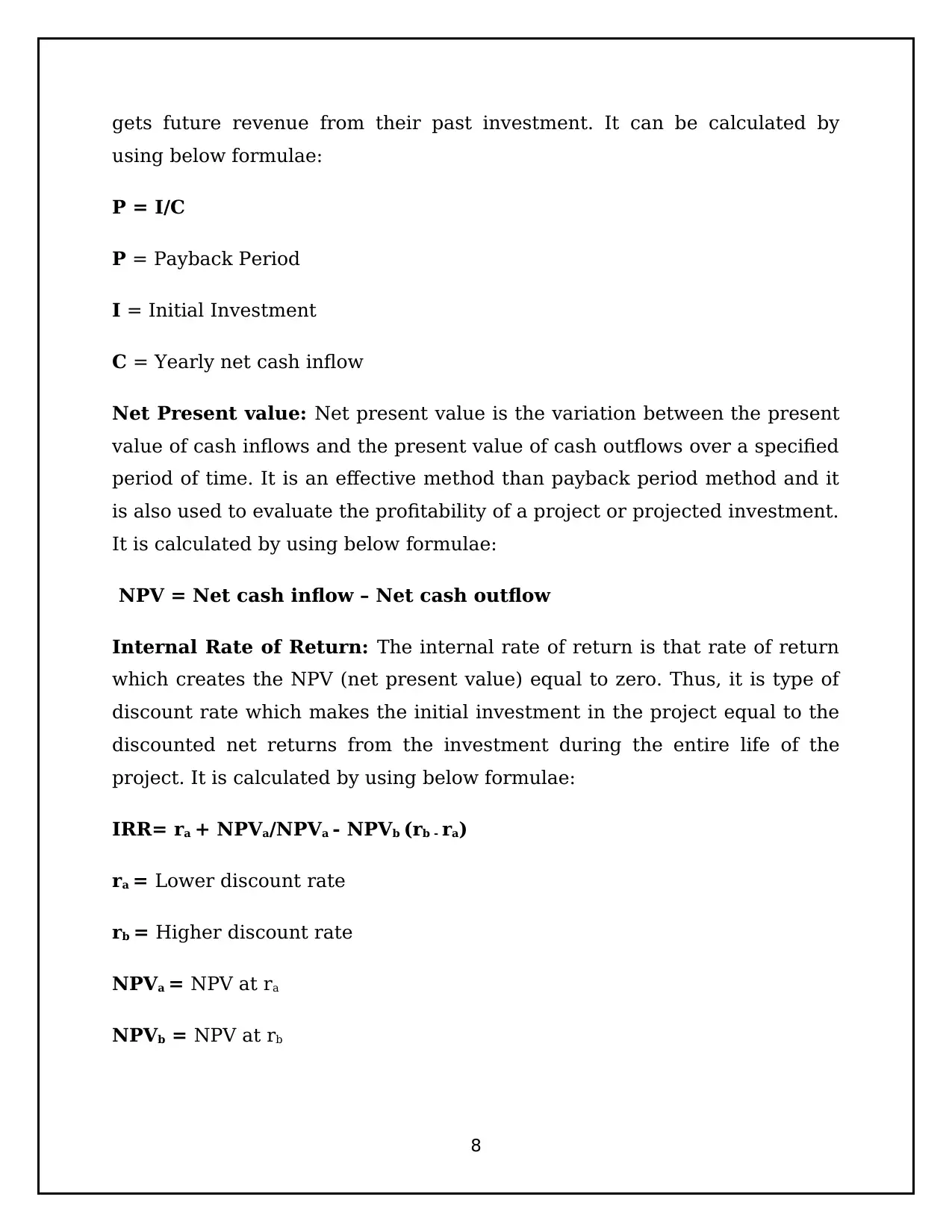
gets future revenue from their past investment. It can be calculated by
using below formulae:
P = I/C
P = Payback Period
I = Initial Investment
C = Yearly net cash inflow
Net Present value: Net present value is the variation between the present
value of cash inflows and the present value of cash outflows over a specified
period of time. It is an effective method than payback period method and it
is also used to evaluate the profitability of a project or projected investment.
It is calculated by using below formulae:
NPV = Net cash inflow – Net cash outflow
Internal Rate of Return: The internal rate of return is that rate of return
which creates the NPV (net present value) equal to zero. Thus, it is type of
discount rate which makes the initial investment in the project equal to the
discounted net returns from the investment during the entire life of the
project. It is calculated by using below formulae:
IRR= ra + NPVa/NPVa - NPVb (rb - ra)
ra = Lower discount rate
rb = Higher discount rate
NPVa = NPV at ra
NPVb = NPV at rb
8
using below formulae:
P = I/C
P = Payback Period
I = Initial Investment
C = Yearly net cash inflow
Net Present value: Net present value is the variation between the present
value of cash inflows and the present value of cash outflows over a specified
period of time. It is an effective method than payback period method and it
is also used to evaluate the profitability of a project or projected investment.
It is calculated by using below formulae:
NPV = Net cash inflow – Net cash outflow
Internal Rate of Return: The internal rate of return is that rate of return
which creates the NPV (net present value) equal to zero. Thus, it is type of
discount rate which makes the initial investment in the project equal to the
discounted net returns from the investment during the entire life of the
project. It is calculated by using below formulae:
IRR= ra + NPVa/NPVa - NPVb (rb - ra)
ra = Lower discount rate
rb = Higher discount rate
NPVa = NPV at ra
NPVb = NPV at rb
8
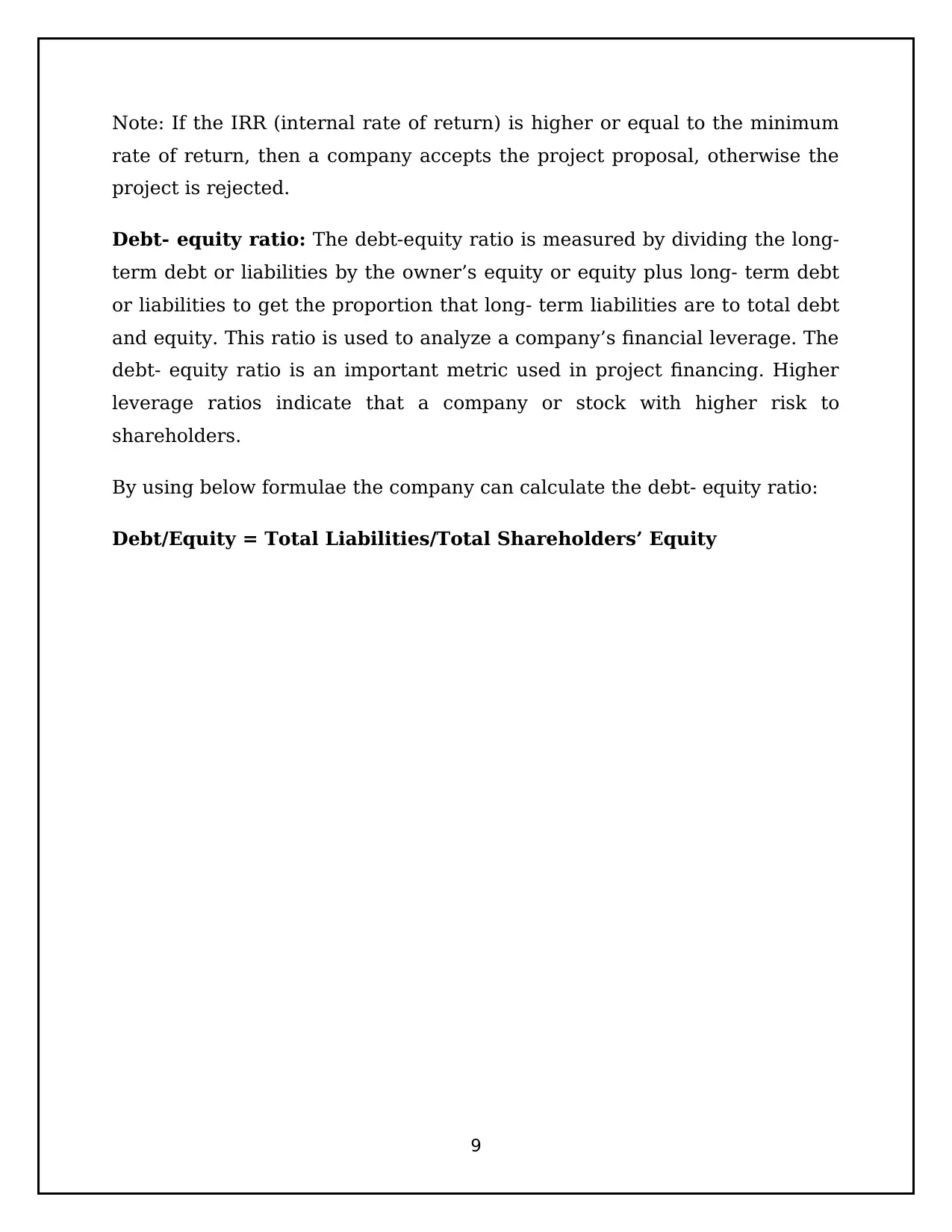
Note: If the IRR (internal rate of return) is higher or equal to the minimum
rate of return, then a company accepts the project proposal, otherwise the
project is rejected.
Debt- equity ratio: The debt-equity ratio is measured by dividing the long-
term debt or liabilities by the owner’s equity or equity plus long- term debt
or liabilities to get the proportion that long- term liabilities are to total debt
and equity. This ratio is used to analyze a company’s financial leverage. The
debt- equity ratio is an important metric used in project financing. Higher
leverage ratios indicate that a company or stock with higher risk to
shareholders.
By using below formulae the company can calculate the debt- equity ratio:
Debt/Equity = Total Liabilities/Total Shareholders’ Equity
9
rate of return, then a company accepts the project proposal, otherwise the
project is rejected.
Debt- equity ratio: The debt-equity ratio is measured by dividing the long-
term debt or liabilities by the owner’s equity or equity plus long- term debt
or liabilities to get the proportion that long- term liabilities are to total debt
and equity. This ratio is used to analyze a company’s financial leverage. The
debt- equity ratio is an important metric used in project financing. Higher
leverage ratios indicate that a company or stock with higher risk to
shareholders.
By using below formulae the company can calculate the debt- equity ratio:
Debt/Equity = Total Liabilities/Total Shareholders’ Equity
9
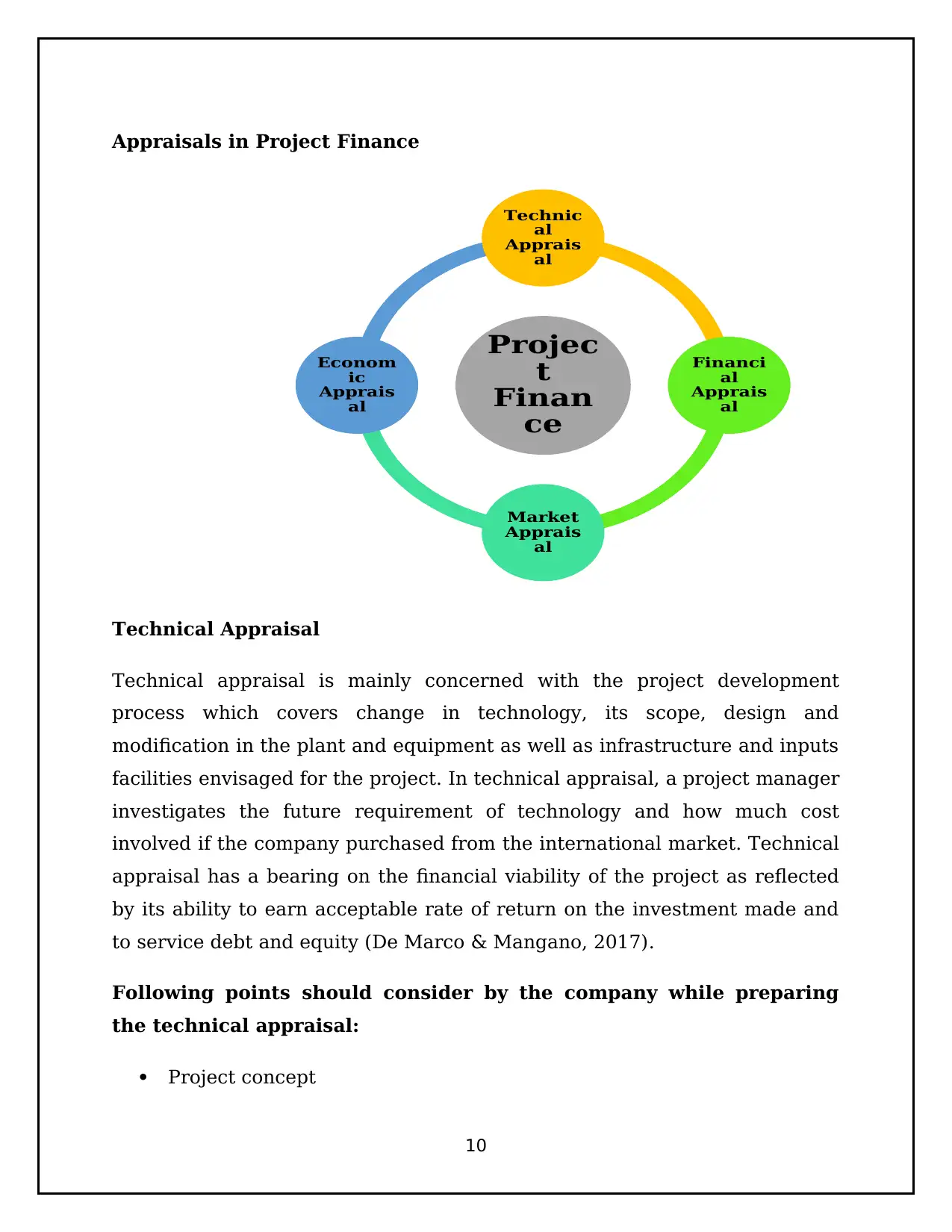
Appraisals in Project Finance
Technical Appraisal
Technical appraisal is mainly concerned with the project development
process which covers change in technology, its scope, design and
modification in the plant and equipment as well as infrastructure and inputs
facilities envisaged for the project. In technical appraisal, a project manager
investigates the future requirement of technology and how much cost
involved if the company purchased from the international market. Technical
appraisal has a bearing on the financial viability of the project as reflected
by its ability to earn acceptable rate of return on the investment made and
to service debt and equity (De Marco & Mangano, 2017).
Following points should consider by the company while preparing
the technical appraisal:
Project concept
10
Projec
t
Finan
ce
Technic
al
Apprais
al
Financi
al
Apprais
al
Market
Apprais
al
Econom
ic
Apprais
al
Technical Appraisal
Technical appraisal is mainly concerned with the project development
process which covers change in technology, its scope, design and
modification in the plant and equipment as well as infrastructure and inputs
facilities envisaged for the project. In technical appraisal, a project manager
investigates the future requirement of technology and how much cost
involved if the company purchased from the international market. Technical
appraisal has a bearing on the financial viability of the project as reflected
by its ability to earn acceptable rate of return on the investment made and
to service debt and equity (De Marco & Mangano, 2017).
Following points should consider by the company while preparing
the technical appraisal:
Project concept
10
Projec
t
Finan
ce
Technic
al
Apprais
al
Financi
al
Apprais
al
Market
Apprais
al
Econom
ic
Apprais
al
Secure Best Marks with AI Grader
Need help grading? Try our AI Grader for instant feedback on your assignments.
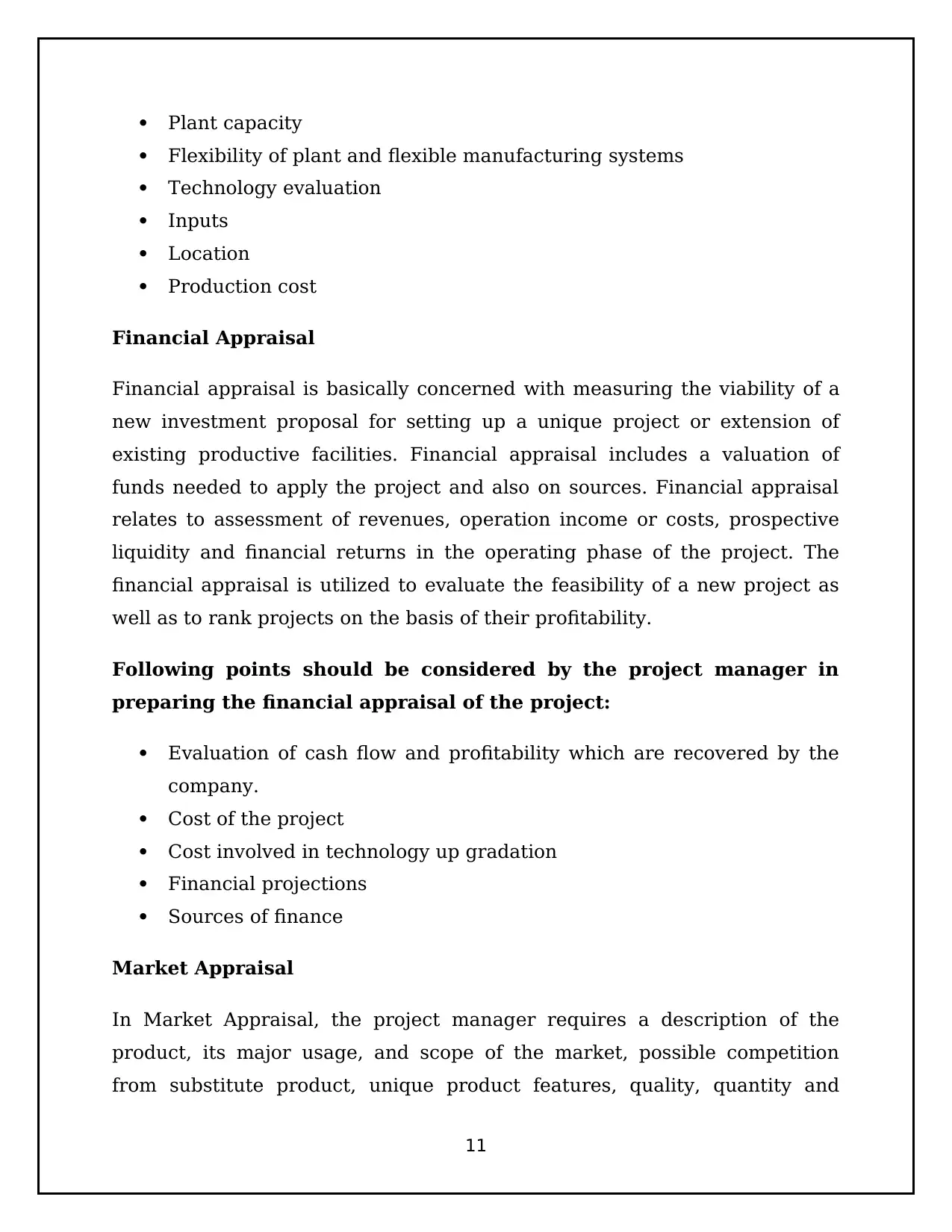
Plant capacity
Flexibility of plant and flexible manufacturing systems
Technology evaluation
Inputs
Location
Production cost
Financial Appraisal
Financial appraisal is basically concerned with measuring the viability of a
new investment proposal for setting up a unique project or extension of
existing productive facilities. Financial appraisal includes a valuation of
funds needed to apply the project and also on sources. Financial appraisal
relates to assessment of revenues, operation income or costs, prospective
liquidity and financial returns in the operating phase of the project. The
financial appraisal is utilized to evaluate the feasibility of a new project as
well as to rank projects on the basis of their profitability.
Following points should be considered by the project manager in
preparing the financial appraisal of the project:
Evaluation of cash flow and profitability which are recovered by the
company.
Cost of the project
Cost involved in technology up gradation
Financial projections
Sources of finance
Market Appraisal
In Market Appraisal, the project manager requires a description of the
product, its major usage, and scope of the market, possible competition
from substitute product, unique product features, quality, quantity and
11
Flexibility of plant and flexible manufacturing systems
Technology evaluation
Inputs
Location
Production cost
Financial Appraisal
Financial appraisal is basically concerned with measuring the viability of a
new investment proposal for setting up a unique project or extension of
existing productive facilities. Financial appraisal includes a valuation of
funds needed to apply the project and also on sources. Financial appraisal
relates to assessment of revenues, operation income or costs, prospective
liquidity and financial returns in the operating phase of the project. The
financial appraisal is utilized to evaluate the feasibility of a new project as
well as to rank projects on the basis of their profitability.
Following points should be considered by the project manager in
preparing the financial appraisal of the project:
Evaluation of cash flow and profitability which are recovered by the
company.
Cost of the project
Cost involved in technology up gradation
Financial projections
Sources of finance
Market Appraisal
In Market Appraisal, the project manager requires a description of the
product, its major usage, and scope of the market, possible competition
from substitute product, unique product features, quality, quantity and
11
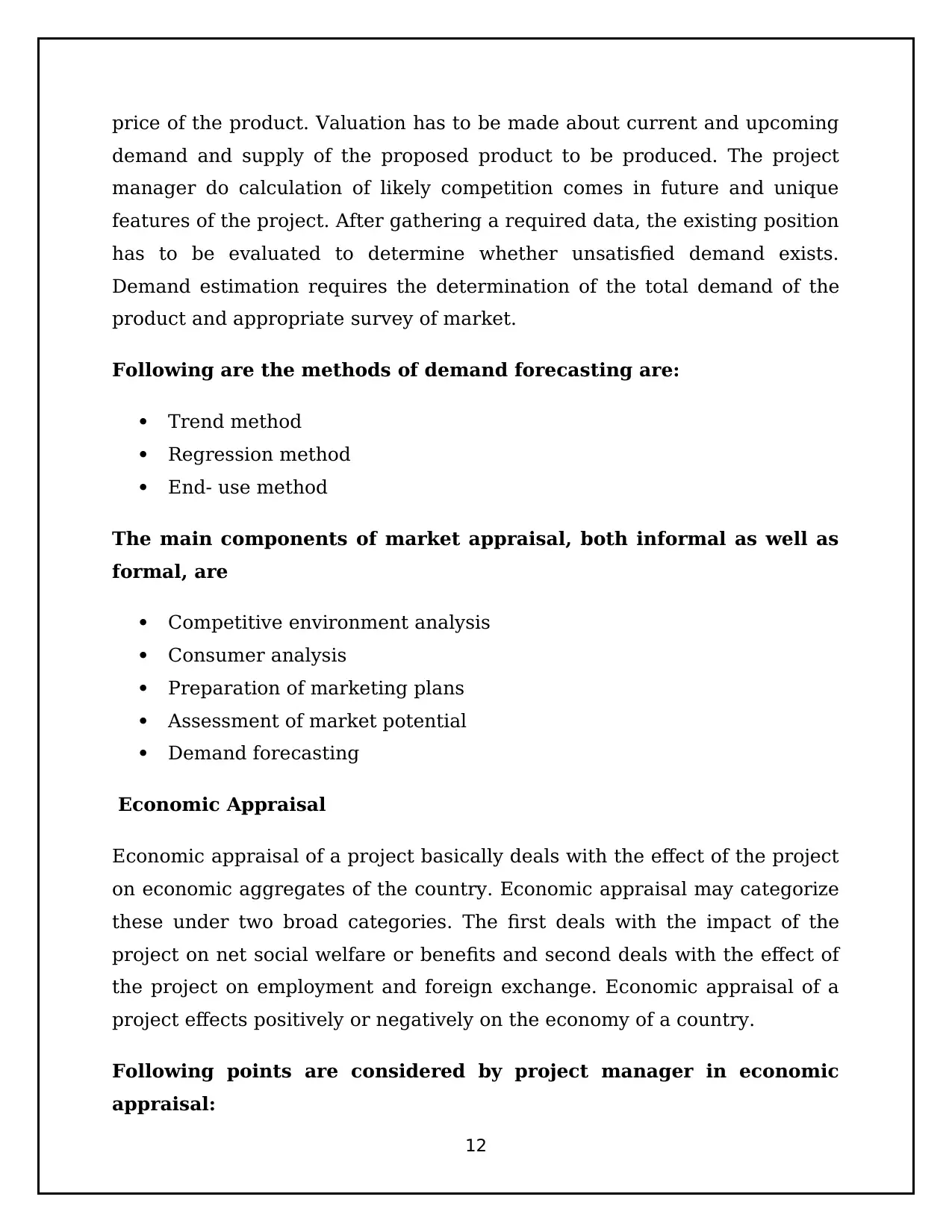
price of the product. Valuation has to be made about current and upcoming
demand and supply of the proposed product to be produced. The project
manager do calculation of likely competition comes in future and unique
features of the project. After gathering a required data, the existing position
has to be evaluated to determine whether unsatisfied demand exists.
Demand estimation requires the determination of the total demand of the
product and appropriate survey of market.
Following are the methods of demand forecasting are:
Trend method
Regression method
End- use method
The main components of market appraisal, both informal as well as
formal, are
Competitive environment analysis
Consumer analysis
Preparation of marketing plans
Assessment of market potential
Demand forecasting
Economic Appraisal
Economic appraisal of a project basically deals with the effect of the project
on economic aggregates of the country. Economic appraisal may categorize
these under two broad categories. The first deals with the impact of the
project on net social welfare or benefits and second deals with the effect of
the project on employment and foreign exchange. Economic appraisal of a
project effects positively or negatively on the economy of a country.
Following points are considered by project manager in economic
appraisal:
12
demand and supply of the proposed product to be produced. The project
manager do calculation of likely competition comes in future and unique
features of the project. After gathering a required data, the existing position
has to be evaluated to determine whether unsatisfied demand exists.
Demand estimation requires the determination of the total demand of the
product and appropriate survey of market.
Following are the methods of demand forecasting are:
Trend method
Regression method
End- use method
The main components of market appraisal, both informal as well as
formal, are
Competitive environment analysis
Consumer analysis
Preparation of marketing plans
Assessment of market potential
Demand forecasting
Economic Appraisal
Economic appraisal of a project basically deals with the effect of the project
on economic aggregates of the country. Economic appraisal may categorize
these under two broad categories. The first deals with the impact of the
project on net social welfare or benefits and second deals with the effect of
the project on employment and foreign exchange. Economic appraisal of a
project effects positively or negatively on the economy of a country.
Following points are considered by project manager in economic
appraisal:
12
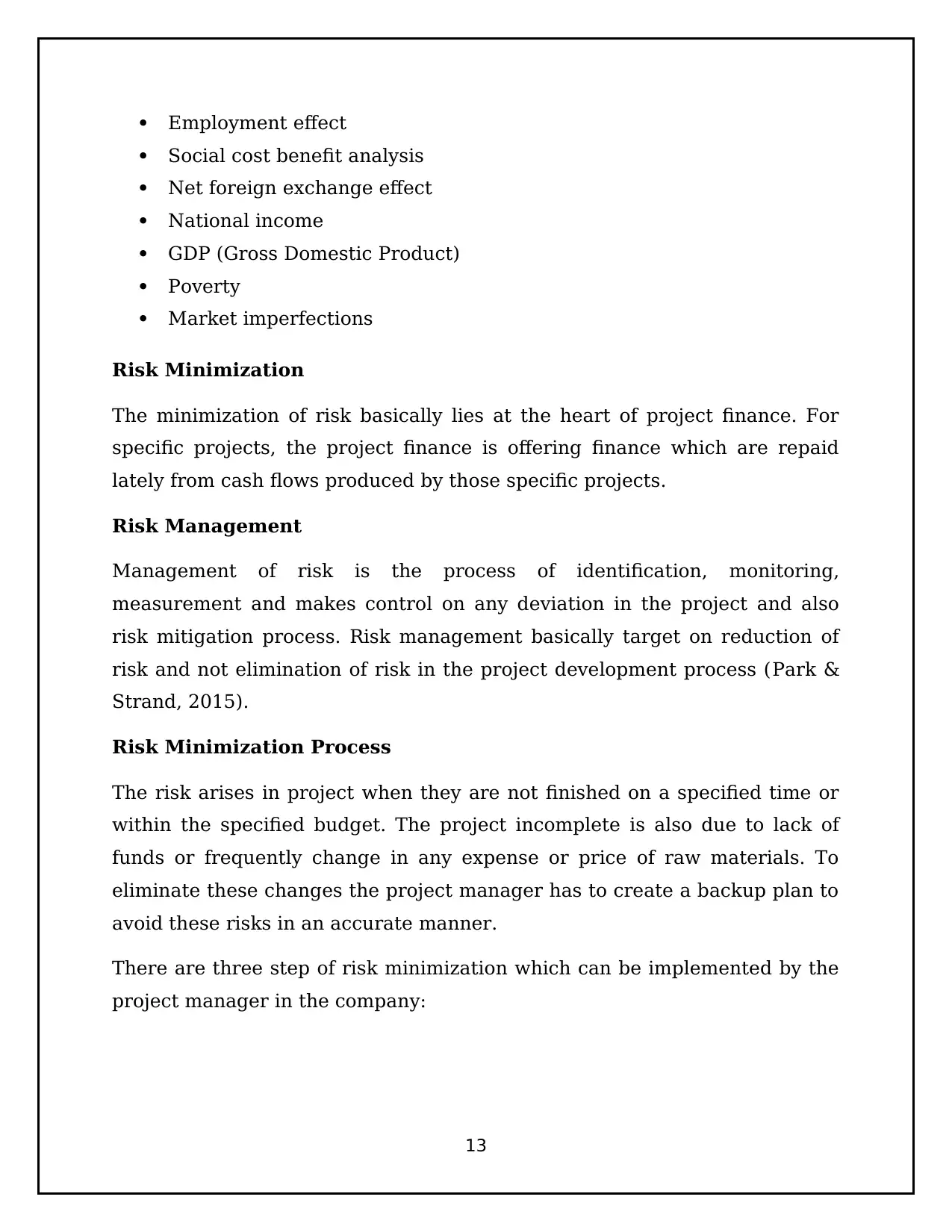
Employment effect
Social cost benefit analysis
Net foreign exchange effect
National income
GDP (Gross Domestic Product)
Poverty
Market imperfections
Risk Minimization
The minimization of risk basically lies at the heart of project finance. For
specific projects, the project finance is offering finance which are repaid
lately from cash flows produced by those specific projects.
Risk Management
Management of risk is the process of identification, monitoring,
measurement and makes control on any deviation in the project and also
risk mitigation process. Risk management basically target on reduction of
risk and not elimination of risk in the project development process (Park &
Strand, 2015).
Risk Minimization Process
The risk arises in project when they are not finished on a specified time or
within the specified budget. The project incomplete is also due to lack of
funds or frequently change in any expense or price of raw materials. To
eliminate these changes the project manager has to create a backup plan to
avoid these risks in an accurate manner.
There are three step of risk minimization which can be implemented by the
project manager in the company:
13
Social cost benefit analysis
Net foreign exchange effect
National income
GDP (Gross Domestic Product)
Poverty
Market imperfections
Risk Minimization
The minimization of risk basically lies at the heart of project finance. For
specific projects, the project finance is offering finance which are repaid
lately from cash flows produced by those specific projects.
Risk Management
Management of risk is the process of identification, monitoring,
measurement and makes control on any deviation in the project and also
risk mitigation process. Risk management basically target on reduction of
risk and not elimination of risk in the project development process (Park &
Strand, 2015).
Risk Minimization Process
The risk arises in project when they are not finished on a specified time or
within the specified budget. The project incomplete is also due to lack of
funds or frequently change in any expense or price of raw materials. To
eliminate these changes the project manager has to create a backup plan to
avoid these risks in an accurate manner.
There are three step of risk minimization which can be implemented by the
project manager in the company:
13
Paraphrase This Document
Need a fresh take? Get an instant paraphrase of this document with our AI Paraphraser
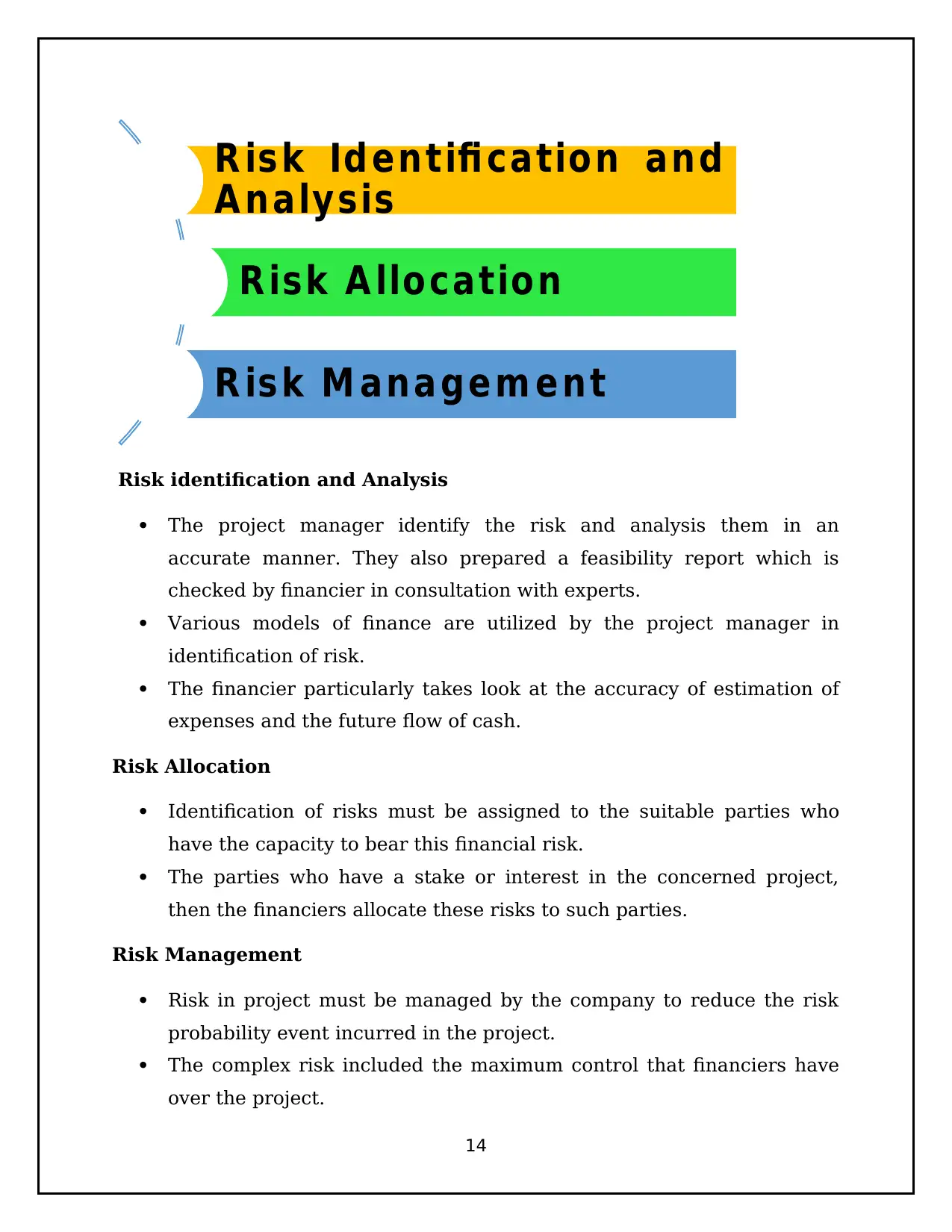
Risk identification and Analysis
The project manager identify the risk and analysis them in an
accurate manner. They also prepared a feasibility report which is
checked by financier in consultation with experts.
Various models of finance are utilized by the project manager in
identification of risk.
The financier particularly takes look at the accuracy of estimation of
expenses and the future flow of cash.
Risk Allocation
Identification of risks must be assigned to the suitable parties who
have the capacity to bear this financial risk.
The parties who have a stake or interest in the concerned project,
then the financiers allocate these risks to such parties.
Risk Management
Risk in project must be managed by the company to reduce the risk
probability event incurred in the project.
The complex risk included the maximum control that financiers have
over the project.
14
R isk Id e n tifi ca tio n a n d
A n a ly sis
R isk A llo ca tio n
R isk M a n a g e m e n t
The project manager identify the risk and analysis them in an
accurate manner. They also prepared a feasibility report which is
checked by financier in consultation with experts.
Various models of finance are utilized by the project manager in
identification of risk.
The financier particularly takes look at the accuracy of estimation of
expenses and the future flow of cash.
Risk Allocation
Identification of risks must be assigned to the suitable parties who
have the capacity to bear this financial risk.
The parties who have a stake or interest in the concerned project,
then the financiers allocate these risks to such parties.
Risk Management
Risk in project must be managed by the company to reduce the risk
probability event incurred in the project.
The complex risk included the maximum control that financiers have
over the project.
14
R isk Id e n tifi ca tio n a n d
A n a ly sis
R isk A llo ca tio n
R isk M a n a g e m e n t

To eliminate the consequences in case, if the events occur.
15
15
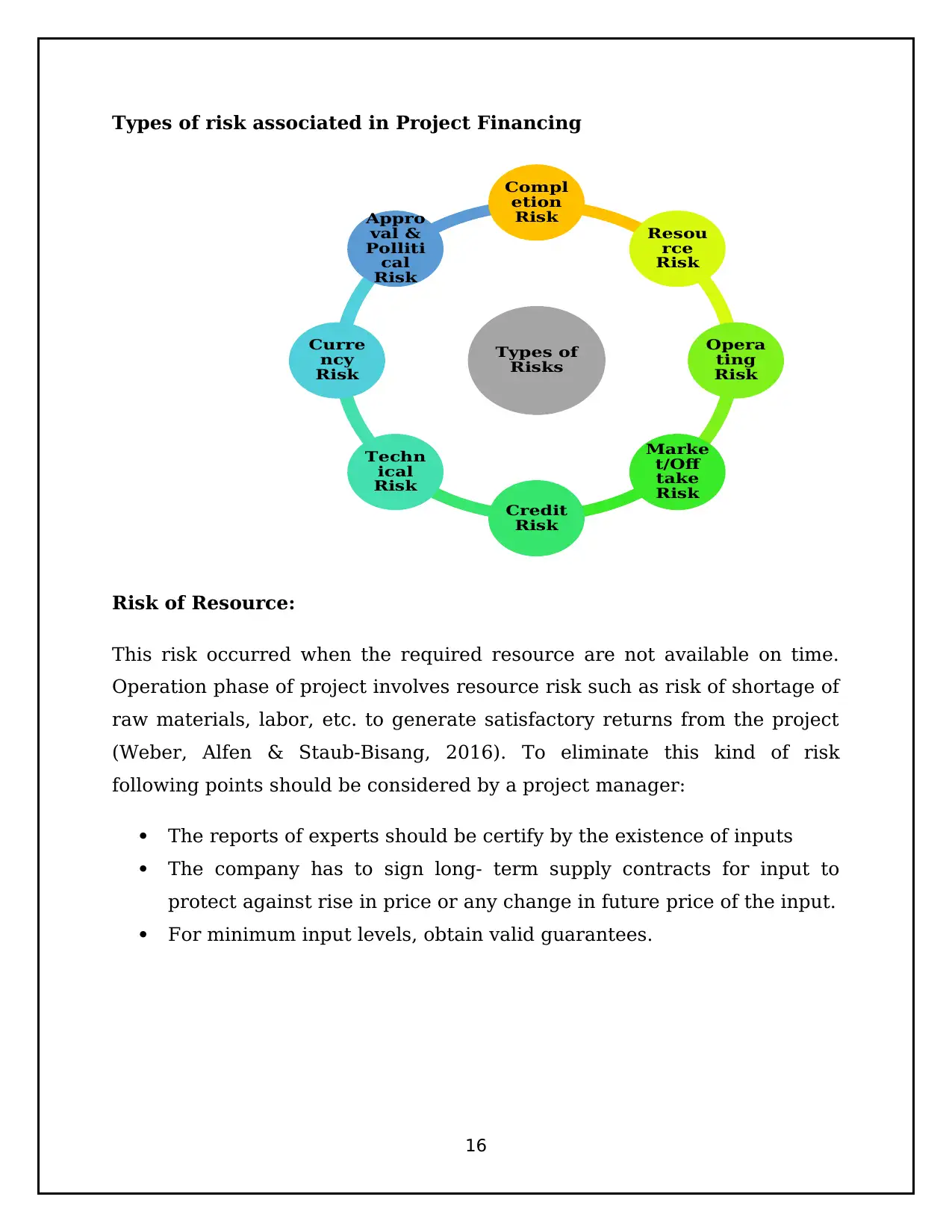
Types of risk associated in Project Financing
Risk of Resource:
This risk occurred when the required resource are not available on time.
Operation phase of project involves resource risk such as risk of shortage of
raw materials, labor, etc. to generate satisfactory returns from the project
(Weber, Alfen & Staub-Bisang, 2016). To eliminate this kind of risk
following points should be considered by a project manager:
The reports of experts should be certify by the existence of inputs
The company has to sign long- term supply contracts for input to
protect against rise in price or any change in future price of the input.
For minimum input levels, obtain valid guarantees.
16
Types of
Risks
Compl
etion
Risk
Resou
rce
Risk
Opera
ting
Risk
Marke
t/Off
take
Risk
Credit
Risk
Techn
ical
Risk
Curre
ncy
Risk
Appro
val &
Polliti
cal
Risk
Risk of Resource:
This risk occurred when the required resource are not available on time.
Operation phase of project involves resource risk such as risk of shortage of
raw materials, labor, etc. to generate satisfactory returns from the project
(Weber, Alfen & Staub-Bisang, 2016). To eliminate this kind of risk
following points should be considered by a project manager:
The reports of experts should be certify by the existence of inputs
The company has to sign long- term supply contracts for input to
protect against rise in price or any change in future price of the input.
For minimum input levels, obtain valid guarantees.
16
Types of
Risks
Compl
etion
Risk
Resou
rce
Risk
Opera
ting
Risk
Marke
t/Off
take
Risk
Credit
Risk
Techn
ical
Risk
Curre
ncy
Risk
Appro
val &
Polliti
cal
Risk
Secure Best Marks with AI Grader
Need help grading? Try our AI Grader for instant feedback on your assignments.
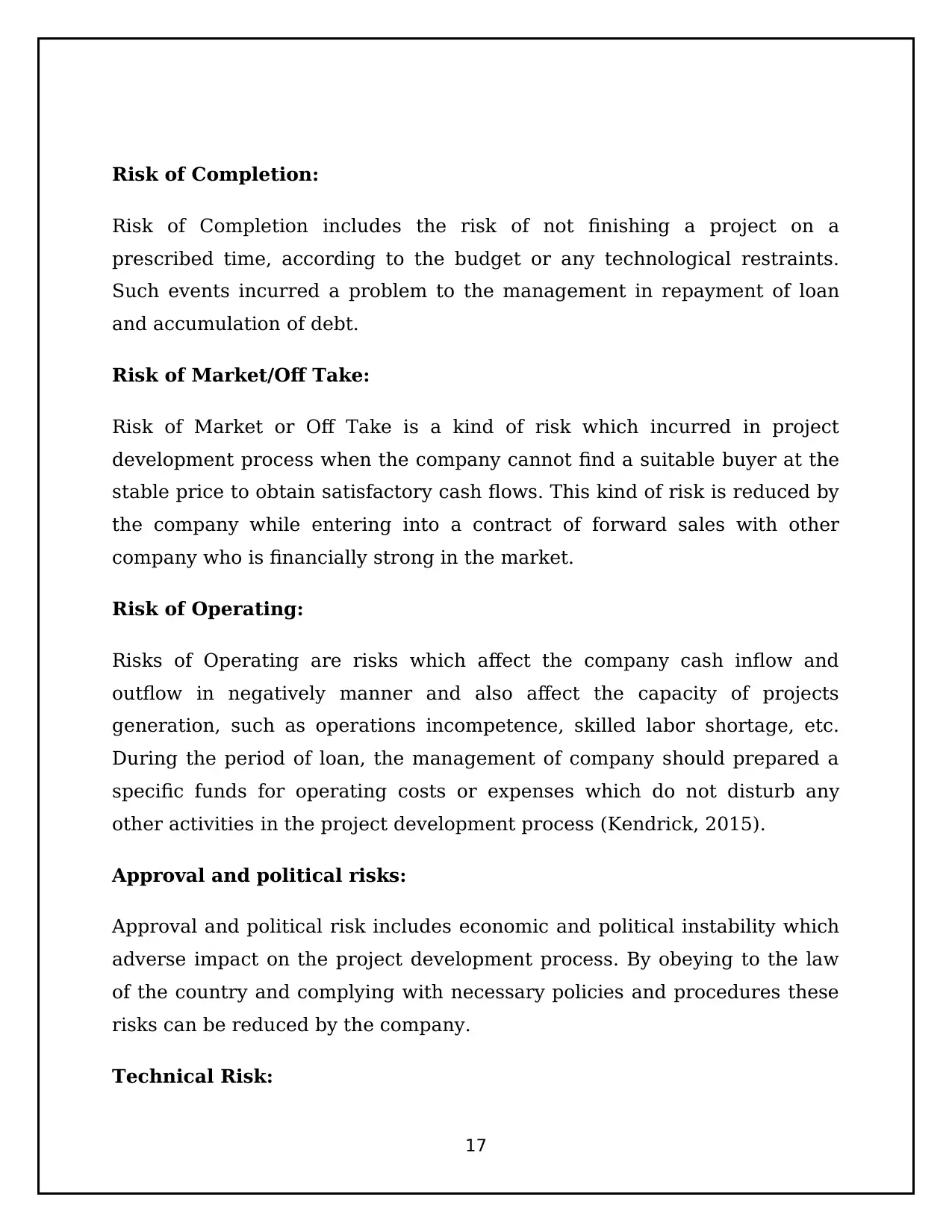
Risk of Completion:
Risk of Completion includes the risk of not finishing a project on a
prescribed time, according to the budget or any technological restraints.
Such events incurred a problem to the management in repayment of loan
and accumulation of debt.
Risk of Market/Off Take:
Risk of Market or Off Take is a kind of risk which incurred in project
development process when the company cannot find a suitable buyer at the
stable price to obtain satisfactory cash flows. This kind of risk is reduced by
the company while entering into a contract of forward sales with other
company who is financially strong in the market.
Risk of Operating:
Risks of Operating are risks which affect the company cash inflow and
outflow in negatively manner and also affect the capacity of projects
generation, such as operations incompetence, skilled labor shortage, etc.
During the period of loan, the management of company should prepared a
specific funds for operating costs or expenses which do not disturb any
other activities in the project development process (Kendrick, 2015).
Approval and political risks:
Approval and political risk includes economic and political instability which
adverse impact on the project development process. By obeying to the law
of the country and complying with necessary policies and procedures these
risks can be reduced by the company.
Technical Risk:
17
Risk of Completion includes the risk of not finishing a project on a
prescribed time, according to the budget or any technological restraints.
Such events incurred a problem to the management in repayment of loan
and accumulation of debt.
Risk of Market/Off Take:
Risk of Market or Off Take is a kind of risk which incurred in project
development process when the company cannot find a suitable buyer at the
stable price to obtain satisfactory cash flows. This kind of risk is reduced by
the company while entering into a contract of forward sales with other
company who is financially strong in the market.
Risk of Operating:
Risks of Operating are risks which affect the company cash inflow and
outflow in negatively manner and also affect the capacity of projects
generation, such as operations incompetence, skilled labor shortage, etc.
During the period of loan, the management of company should prepared a
specific funds for operating costs or expenses which do not disturb any
other activities in the project development process (Kendrick, 2015).
Approval and political risks:
Approval and political risk includes economic and political instability which
adverse impact on the project development process. By obeying to the law
of the country and complying with necessary policies and procedures these
risks can be reduced by the company.
Technical Risk:
17
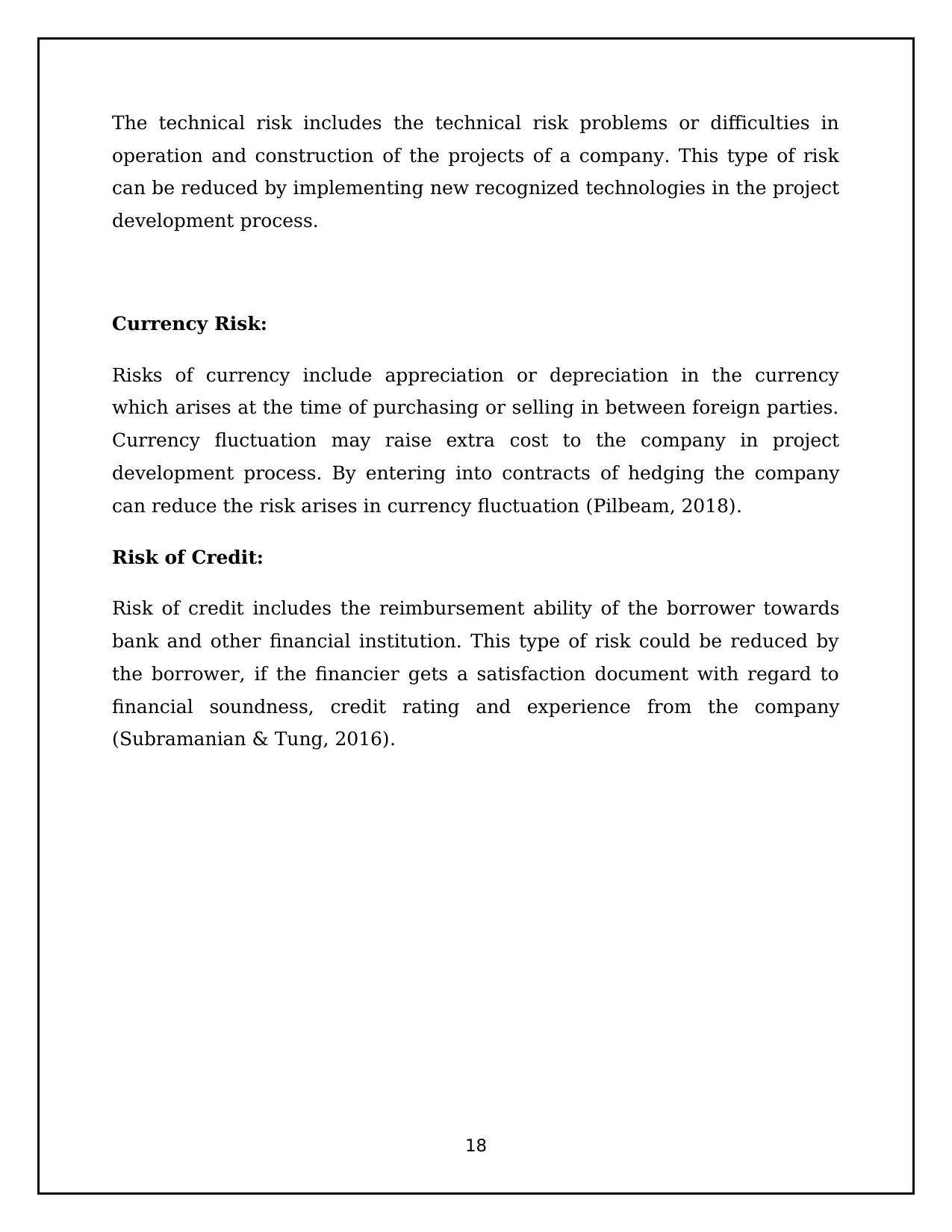
The technical risk includes the technical risk problems or difficulties in
operation and construction of the projects of a company. This type of risk
can be reduced by implementing new recognized technologies in the project
development process.
Currency Risk:
Risks of currency include appreciation or depreciation in the currency
which arises at the time of purchasing or selling in between foreign parties.
Currency fluctuation may raise extra cost to the company in project
development process. By entering into contracts of hedging the company
can reduce the risk arises in currency fluctuation (Pilbeam, 2018).
Risk of Credit:
Risk of credit includes the reimbursement ability of the borrower towards
bank and other financial institution. This type of risk could be reduced by
the borrower, if the financier gets a satisfaction document with regard to
financial soundness, credit rating and experience from the company
(Subramanian & Tung, 2016).
18
operation and construction of the projects of a company. This type of risk
can be reduced by implementing new recognized technologies in the project
development process.
Currency Risk:
Risks of currency include appreciation or depreciation in the currency
which arises at the time of purchasing or selling in between foreign parties.
Currency fluctuation may raise extra cost to the company in project
development process. By entering into contracts of hedging the company
can reduce the risk arises in currency fluctuation (Pilbeam, 2018).
Risk of Credit:
Risk of credit includes the reimbursement ability of the borrower towards
bank and other financial institution. This type of risk could be reduced by
the borrower, if the financier gets a satisfaction document with regard to
financial soundness, credit rating and experience from the company
(Subramanian & Tung, 2016).
18
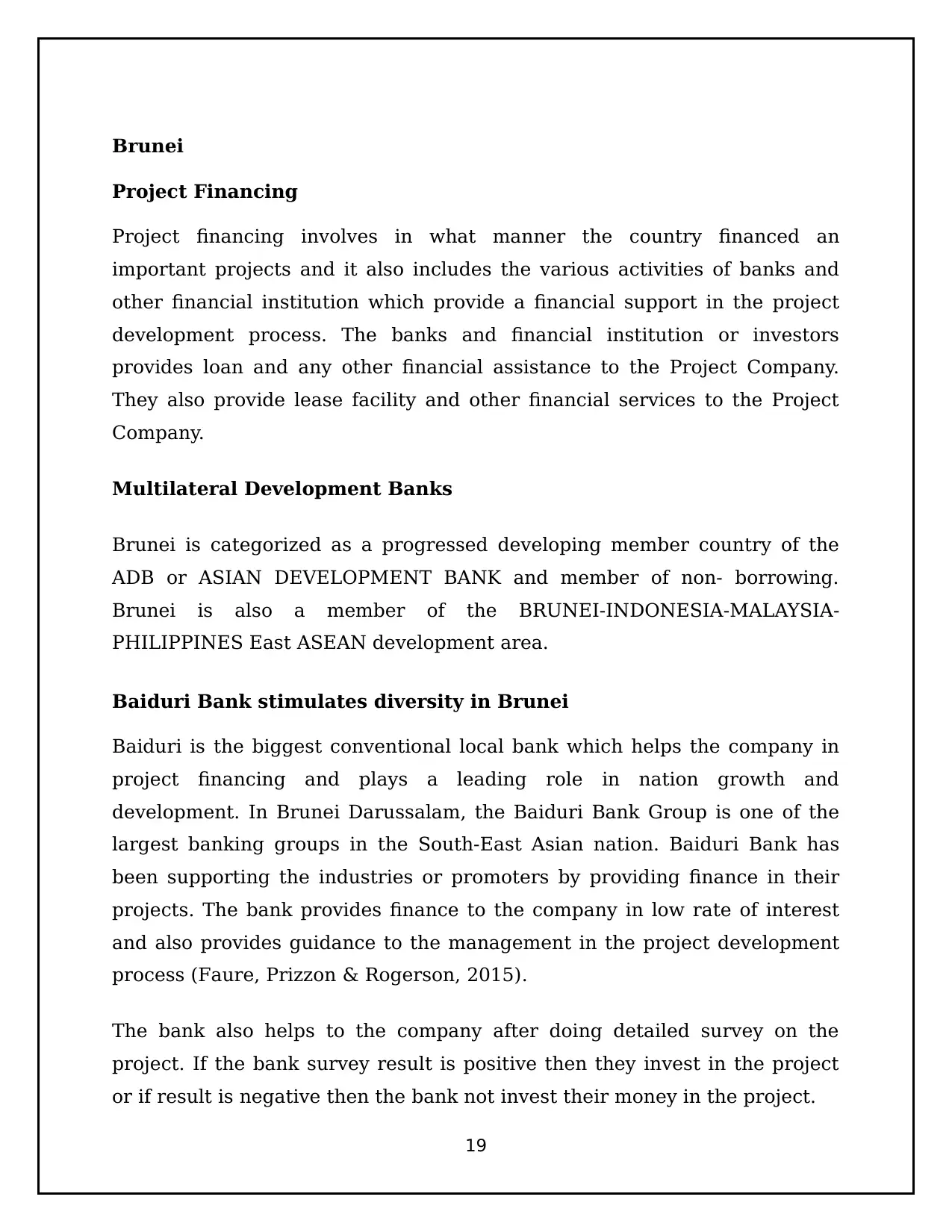
Brunei
Project Financing
Project financing involves in what manner the country financed an
important projects and it also includes the various activities of banks and
other financial institution which provide a financial support in the project
development process. The banks and financial institution or investors
provides loan and any other financial assistance to the Project Company.
They also provide lease facility and other financial services to the Project
Company.
Multilateral Development Banks
Brunei is categorized as a progressed developing member country of the
ADB or ASIAN DEVELOPMENT BANK and member of non- borrowing.
Brunei is also a member of the BRUNEI-INDONESIA-MALAYSIA-
PHILIPPINES East ASEAN development area.
Baiduri Bank stimulates diversity in Brunei
Baiduri is the biggest conventional local bank which helps the company in
project financing and plays a leading role in nation growth and
development. In Brunei Darussalam, the Baiduri Bank Group is one of the
largest banking groups in the South-East Asian nation. Baiduri Bank has
been supporting the industries or promoters by providing finance in their
projects. The bank provides finance to the company in low rate of interest
and also provides guidance to the management in the project development
process (Faure, Prizzon & Rogerson, 2015).
The bank also helps to the company after doing detailed survey on the
project. If the bank survey result is positive then they invest in the project
or if result is negative then the bank not invest their money in the project.
19
Project Financing
Project financing involves in what manner the country financed an
important projects and it also includes the various activities of banks and
other financial institution which provide a financial support in the project
development process. The banks and financial institution or investors
provides loan and any other financial assistance to the Project Company.
They also provide lease facility and other financial services to the Project
Company.
Multilateral Development Banks
Brunei is categorized as a progressed developing member country of the
ADB or ASIAN DEVELOPMENT BANK and member of non- borrowing.
Brunei is also a member of the BRUNEI-INDONESIA-MALAYSIA-
PHILIPPINES East ASEAN development area.
Baiduri Bank stimulates diversity in Brunei
Baiduri is the biggest conventional local bank which helps the company in
project financing and plays a leading role in nation growth and
development. In Brunei Darussalam, the Baiduri Bank Group is one of the
largest banking groups in the South-East Asian nation. Baiduri Bank has
been supporting the industries or promoters by providing finance in their
projects. The bank provides finance to the company in low rate of interest
and also provides guidance to the management in the project development
process (Faure, Prizzon & Rogerson, 2015).
The bank also helps to the company after doing detailed survey on the
project. If the bank survey result is positive then they invest in the project
or if result is negative then the bank not invest their money in the project.
19
Paraphrase This Document
Need a fresh take? Get an instant paraphrase of this document with our AI Paraphraser

20
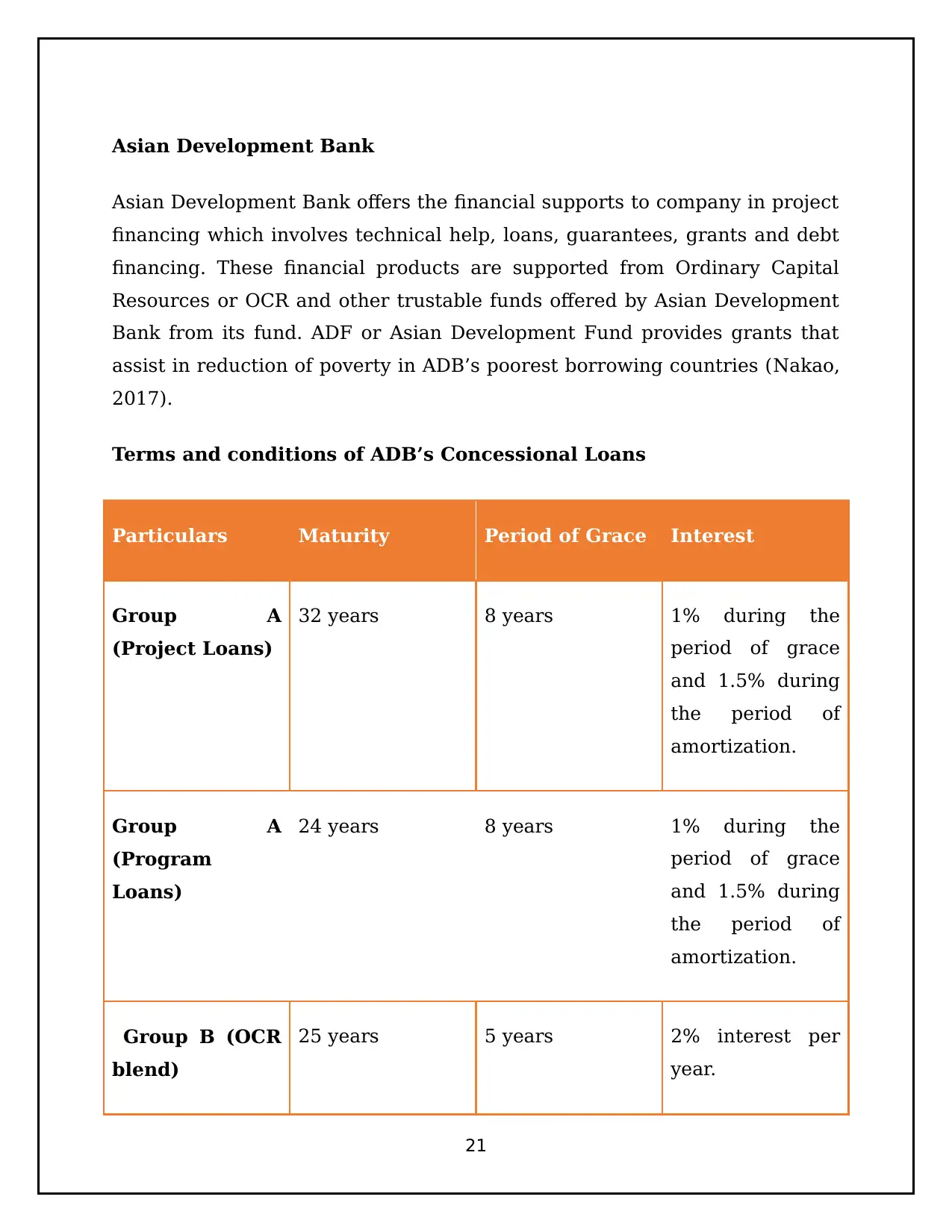
Asian Development Bank
Asian Development Bank offers the financial supports to company in project
financing which involves technical help, loans, guarantees, grants and debt
financing. These financial products are supported from Ordinary Capital
Resources or OCR and other trustable funds offered by Asian Development
Bank from its fund. ADF or Asian Development Fund provides grants that
assist in reduction of poverty in ADB’s poorest borrowing countries (Nakao,
2017).
Terms and conditions of ADB’s Concessional Loans
Particulars Maturity Period of Grace Interest
Group A
(Project Loans)
32 years 8 years 1% during the
period of grace
and 1.5% during
the period of
amortization.
Group A
(Program
Loans)
24 years 8 years 1% during the
period of grace
and 1.5% during
the period of
amortization.
Group B (OCR
blend)
25 years 5 years 2% interest per
year.
21
Asian Development Bank offers the financial supports to company in project
financing which involves technical help, loans, guarantees, grants and debt
financing. These financial products are supported from Ordinary Capital
Resources or OCR and other trustable funds offered by Asian Development
Bank from its fund. ADF or Asian Development Fund provides grants that
assist in reduction of poverty in ADB’s poorest borrowing countries (Nakao,
2017).
Terms and conditions of ADB’s Concessional Loans
Particulars Maturity Period of Grace Interest
Group A
(Project Loans)
32 years 8 years 1% during the
period of grace
and 1.5% during
the period of
amortization.
Group A
(Program
Loans)
24 years 8 years 1% during the
period of grace
and 1.5% during
the period of
amortization.
Group B (OCR
blend)
25 years 5 years 2% interest per
year.
21
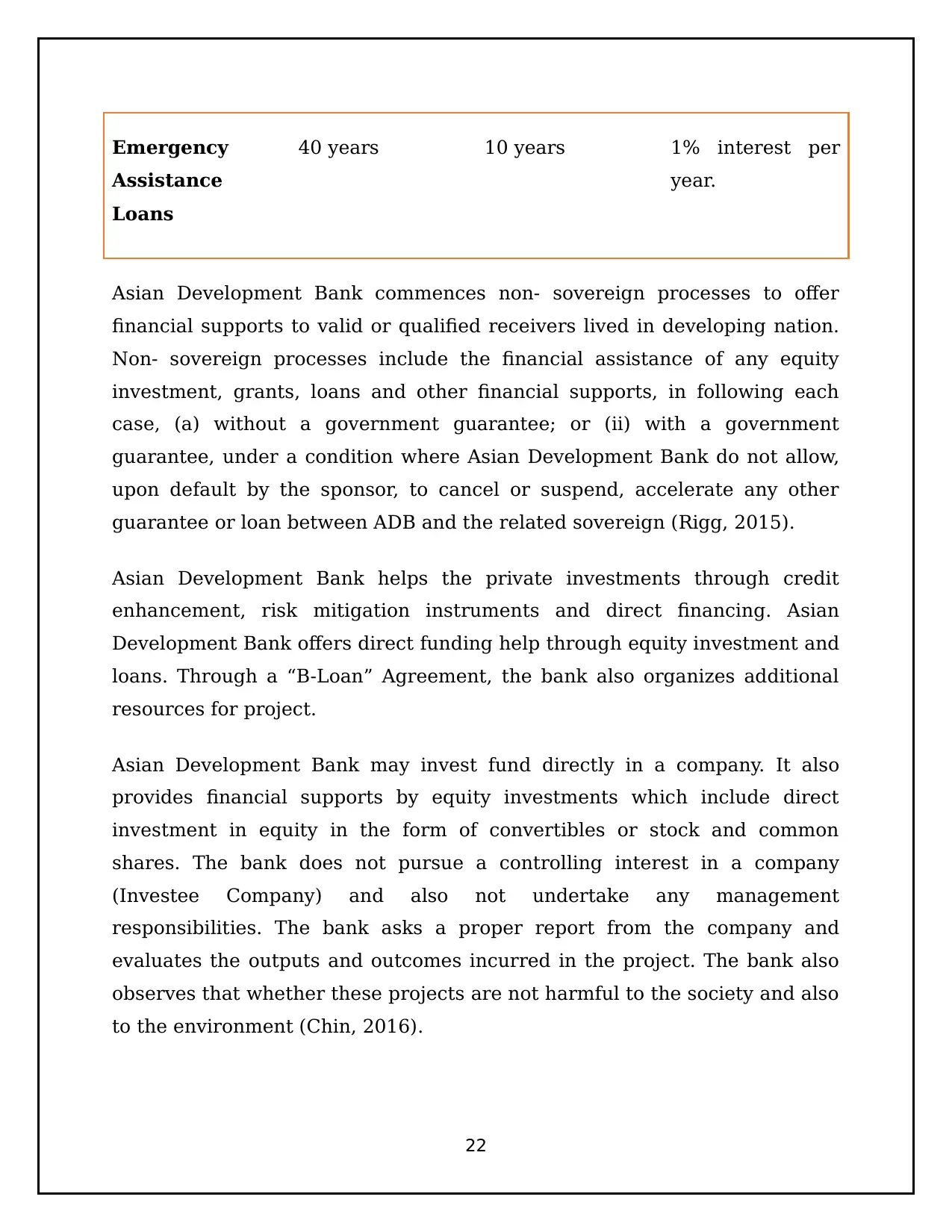
Emergency
Assistance
Loans
40 years 10 years 1% interest per
year.
Asian Development Bank commences non- sovereign processes to offer
financial supports to valid or qualified receivers lived in developing nation.
Non- sovereign processes include the financial assistance of any equity
investment, grants, loans and other financial supports, in following each
case, (a) without a government guarantee; or (ii) with a government
guarantee, under a condition where Asian Development Bank do not allow,
upon default by the sponsor, to cancel or suspend, accelerate any other
guarantee or loan between ADB and the related sovereign (Rigg, 2015).
Asian Development Bank helps the private investments through credit
enhancement, risk mitigation instruments and direct financing. Asian
Development Bank offers direct funding help through equity investment and
loans. Through a “B-Loan” Agreement, the bank also organizes additional
resources for project.
Asian Development Bank may invest fund directly in a company. It also
provides financial supports by equity investments which include direct
investment in equity in the form of convertibles or stock and common
shares. The bank does not pursue a controlling interest in a company
(Investee Company) and also not undertake any management
responsibilities. The bank asks a proper report from the company and
evaluates the outputs and outcomes incurred in the project. The bank also
observes that whether these projects are not harmful to the society and also
to the environment (Chin, 2016).
22
Assistance
Loans
40 years 10 years 1% interest per
year.
Asian Development Bank commences non- sovereign processes to offer
financial supports to valid or qualified receivers lived in developing nation.
Non- sovereign processes include the financial assistance of any equity
investment, grants, loans and other financial supports, in following each
case, (a) without a government guarantee; or (ii) with a government
guarantee, under a condition where Asian Development Bank do not allow,
upon default by the sponsor, to cancel or suspend, accelerate any other
guarantee or loan between ADB and the related sovereign (Rigg, 2015).
Asian Development Bank helps the private investments through credit
enhancement, risk mitigation instruments and direct financing. Asian
Development Bank offers direct funding help through equity investment and
loans. Through a “B-Loan” Agreement, the bank also organizes additional
resources for project.
Asian Development Bank may invest fund directly in a company. It also
provides financial supports by equity investments which include direct
investment in equity in the form of convertibles or stock and common
shares. The bank does not pursue a controlling interest in a company
(Investee Company) and also not undertake any management
responsibilities. The bank asks a proper report from the company and
evaluates the outputs and outcomes incurred in the project. The bank also
observes that whether these projects are not harmful to the society and also
to the environment (Chin, 2016).
22
1 out of 22
Your All-in-One AI-Powered Toolkit for Academic Success.
+13062052269
info@desklib.com
Available 24*7 on WhatsApp / Email
![[object Object]](/_next/static/media/star-bottom.7253800d.svg)
Unlock your academic potential
© 2024 | Zucol Services PVT LTD | All rights reserved.





